belt AUDI A8 2013 Repair Manual
[x] Cancel search | Manufacturer: AUDI, Model Year: 2013, Model line: A8, Model: AUDI A8 2013Pages: 318, PDF Size: 79.34 MB
Page 191 of 318
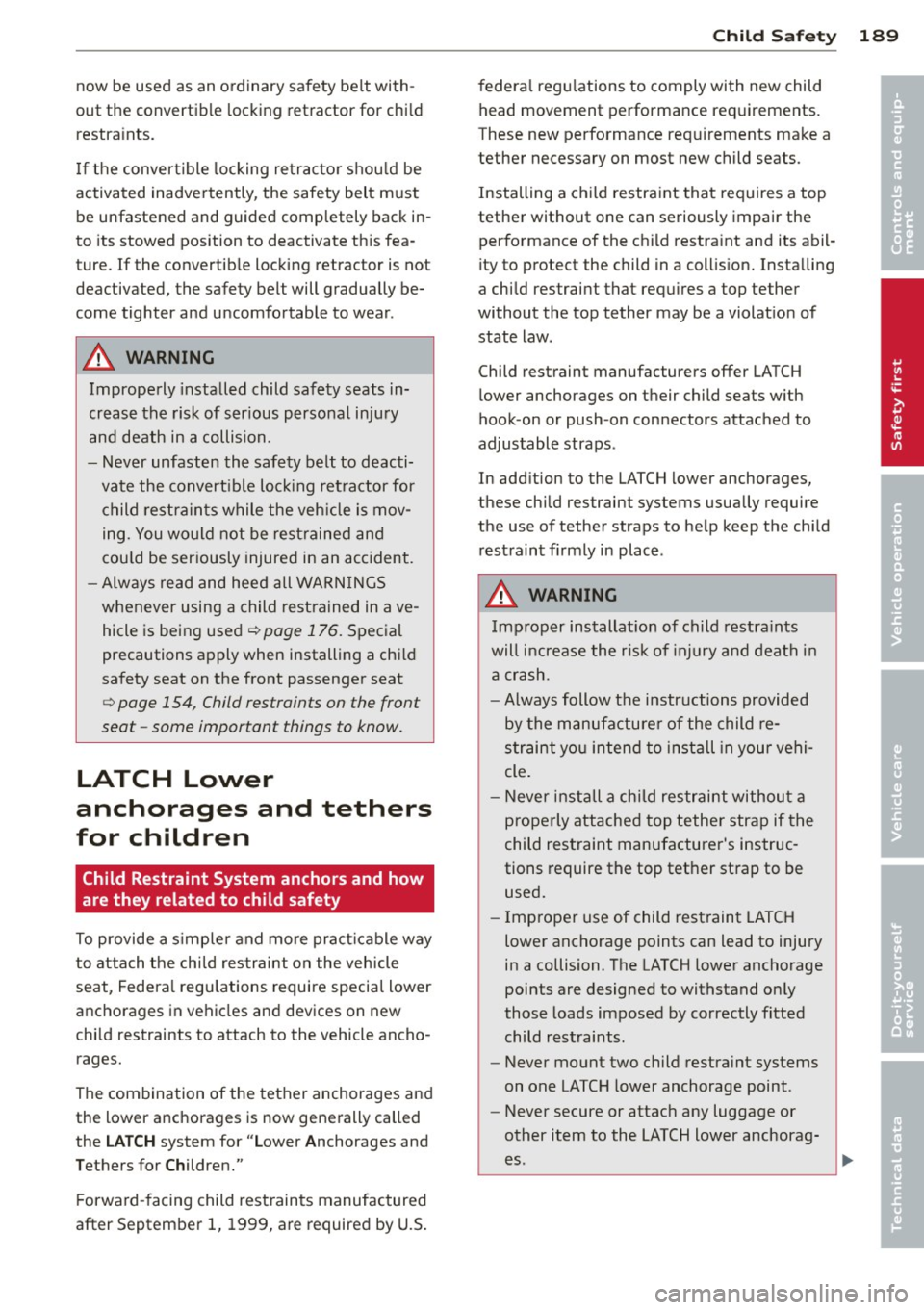
now be used as an ordinary safety belt with
out the convertible locking retractor for child
restra ints.
I f the convertible locking retractor shou ld be
activated inadvertently, the safety belt must
be unfastened and guided completely back in
to its stowed position to deactivate this fea
ture.
If the convertib le locking retractor is not
deactivated, the safety belt will gradually be
come tighter and uncomfortable to wear .
A WARNING
Improperly installed child safety seats in
crease the risk of ser ious personal injury
and death in a collision.
- Never unfasten the safety belt to deacti
vate the convert ible lock ing ret ractor for
c hild restraints while the veh icle is mov
ing. You would not be restrained and
cou ld be ser iously injured in an accident.
- Always read and heed all WARN INGS
whenever using a child rest rained in ave
hicle is being used¢
page 176. Special
precautions apply when installing a chi ld
safety seat on the front passenger seat
¢ page 154, Child restraints on the front
seat -some important things to know.
LATCH Lower
anchorages and tethers
for children
Child Restraint System anchors and how
are they related to child safety
To provide a s imp le r and more pract icable way
to attach the ch ild res traint on the veh icle
seat, Federa l regu lations require specia l lower
anchorages in vehicles and devices on new
chi ld restraints to attach to the vehicle ancho
rages.
The combination of the tether anchorages and
the lower anchorages is now generally called
the
LA TCH system for "Lower Anchorages and
T ethers for Children."
F orward- facing child restraints manufactured
after September 1, 1999, are required by U.S.
Child Sa fet y 189
federa l reg ulations to comply with new child
head movement performance requirements.
These new performance requirements make a
tether necessary on most new child seats.
Installing a ch ild restra int that requires a top
tethe r without one can seriously impair the
performance of the c hild restra int and its abil
ity to protect the child in a collis ion. Insta lling
a child restraint that requires a top tether
without the top tether may be a violat ion of
state law.
Child restraint manufacturers offer LATCH
lower anchorages on their child seats with
hook-on or push-on connectors attached to
adjustable straps.
In add ition to the LATCH lower anchorages,
these child restraint systems usually require
the use of tether straps to help keep the ch ild
restraint firmly in place.
A WARNING
Imp roper installat ion of child restra ints
will increase the r isk of injury a nd death in
a cr ash.
- Always follow the instr uctions provided
by the manufa cture r of the child re
s traint yo u intend to install in your vehi
cle.
- Never inst all a child restraint withou t a
properly attached top tether strap if the
child restraint manufacturer's instruc
tions require the top tether strap to be
used.
- Improper use of child rest raint LATCH
lowe r ancho rage points can lead to injury
in a collision. The LATCH lower anchorage
points are designed to withstand on ly
those loads imposed by correctly fitted
child restraints.
- Never mount two child restra int systems
on one LATCH lower anchorage point.
- Never secure or attach any luggage or
other item to the LATCH lower anchorag-
-
es. Ill-
•
•
Page 192 of 318
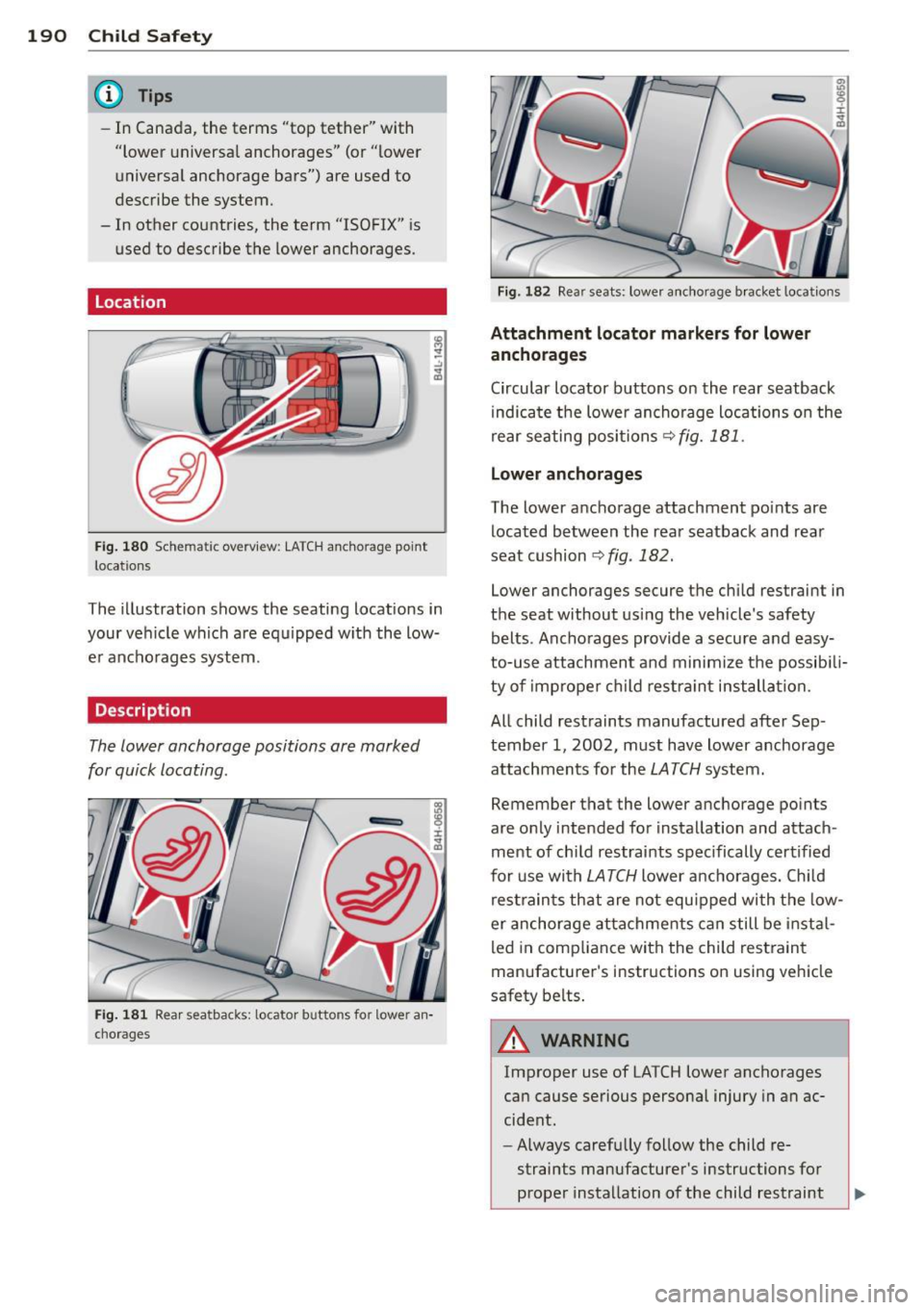
190 Child Safe ty
@ Tips
- In Canada, the terms "top tether" with
"lower universa l anchorages" (or "lower
universal anchorage bars") are used to
describe the system.
- In other countries, the term "ISO FIX" is used to describe the lower anchorages .
Location
Fig. 180 Sch ematic overv ie w: LA TCH ancho rage point
l oca tion s
The illustration shows the seating locations in
your veh icle which are equipped w ith the low
e r anchorages system.
Description
The lower anchorage positions are marked
for quick locating .
Fig. 181 Re ar seatbacks : loca tor b utto ns fo r low er an
chor ages
Fig. 182 Rea r seats: lowe r an cho rage b racket loc ations
Atta chment l oca to r marker s fo r lowe r
anchor ages
Circular locator buttons on the rear seatback
indica te t he lower an chorage locations on the
rear seating posi tions
¢ fig. 181.
L o w er anch orages
The lower anchorage attachment points are
located between the rear seatback and rear
seat cushion
¢ fig . 182.
Lower anchorages secure the child res train t in
the seat without using the vehicle's safety belts . Anchorages provide a secure and easy
to-use attachment and minimize the possibili
ty of improper ch ild restra int installation.
All child restraints manufactured after Sep
tember 1, 2002 , must have lower anchorage
attachments for the
LATCH system.
Remember that the lower anchorage po ints
are o nly intended for installation and attach
ment of child restraints specifically certified
for use with
LATCH lower anchorages. Chi ld
rest raints that are not equipped with the low
er anchorage attachments can still be insta l
led in compliance with the child restraint
manufacturer 's instructions on us ing vehicle
safety belts .
Ln._ WARNING
-Improper use of LATCH lower anchorages
can cause serious personal injury in an ac
cident.
- Always carefu lly follow the child re
straints manufacturer's instructions for
proper installation of the child restraint
Page 193 of 318
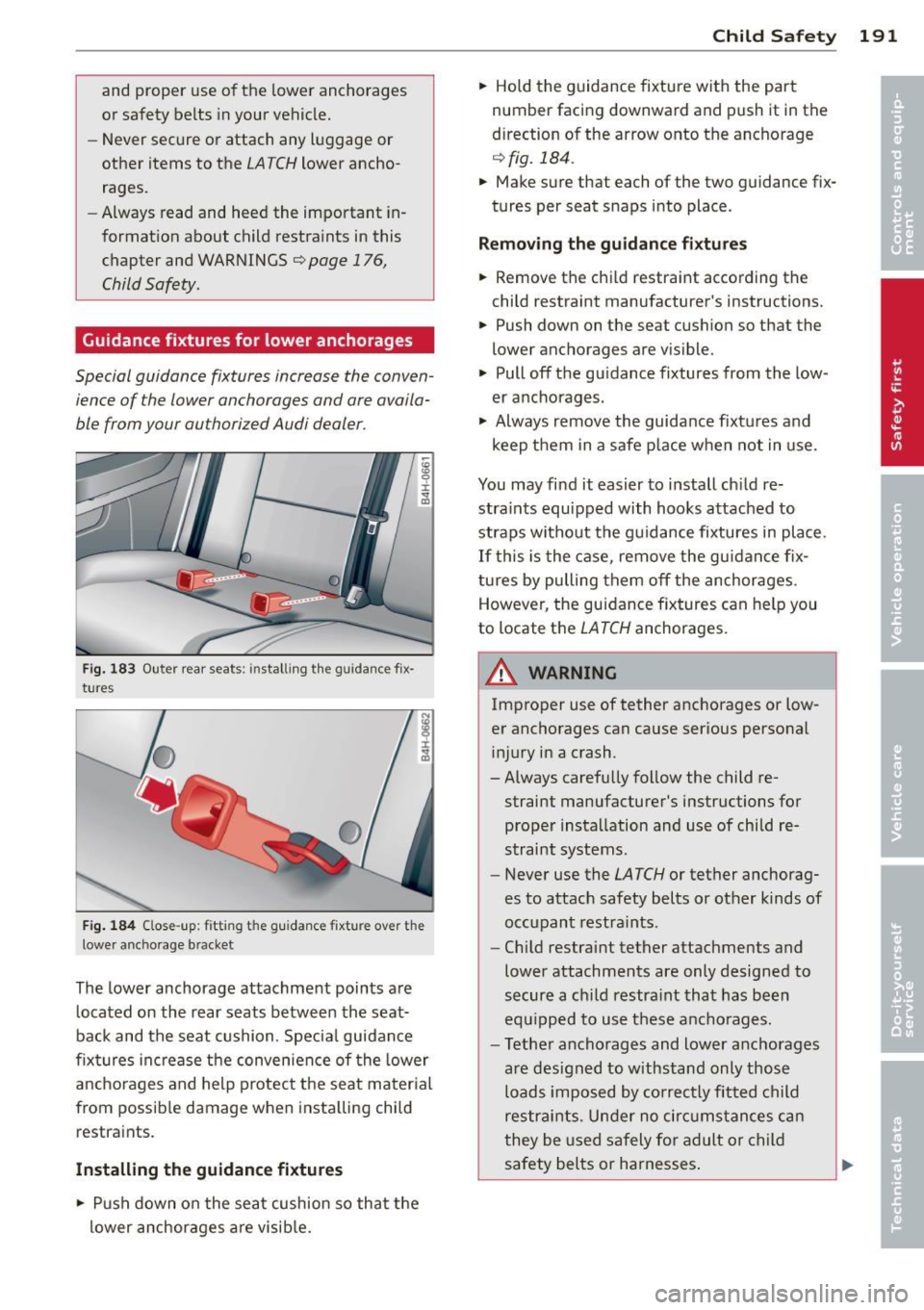
and proper use of the lower anchorages
or safety belts in your vehicle.
- Never secure or attach any l uggage or
other items to the
LATCH lower ancho
rages .
- Always read and heed the important in
formation about child restra ints in this
chapter and WARNINGS
¢ page 176,
Child Safety.
Guidance fixtures for lower anchorages
Special guidance fixtures increase the conven
ience of the lower anchorages and are availa
ble from your au thori zed Audi dealer .
Fig. 183 Outer rear seat s: in stallin g th e guid ance fix
tu res
F ig . 184 Clo se -up : fittin g the guidance fixt ur e ov er th e
l ower a nch o rage b rack et
The lower anchorage attachment points are
located on the rear seats between the seat
back and the seat cushion . Specia l guidance
fix tures increase the convenience of the lower
ancho rages and help protect the seat mater ial
from possib le damage when installing child
restraints.
Install ing th e guidance fixtures
.,. Push down on the seat cushion so that the
lower anchorages are visib le.
Child S afety 191
.,. Hold the guidance fixture with the part
number facing downward and push it in the
direction of the arrow onto the anchorage
¢ fig. 184.
.,. Make sure that each of the two guidance fix
tures per seat snaps into place .
Removing th e guid ance fixtures
.,. Remove the ch ild restraint according the
child restraint manufacturer's instructions .
.,. Push down on the seat cushion so that the
lower anchorages are v isible .
.,. Pull off the gu idance fixtures from the low
er anchorages .
.,. Always remove the guidance fixtures and
keep them in a safe p lace when not in use.
You may find it easier to install ch ild re
stra ints equipped with hooks attached to
straps without the guidance fixtures in place .
If this is the case, remove the guidance fix
tures by pulling them off the anchorages. However , the guidance fixtures can help you
to locate the
LATCH anchorages.
A WARNING
Improper use of tether anchorages or low
er anchorages can cause serious personal injury in a crash .
- Always carefully follow the child re straint manufacturer's instructions for proper insta llation and use of child re
straint systems.
- Never use the
LATCH or tether anchorag
es to attach safety belts or other k inds of
occupant restra ints .
- Ch ild restraint tether attachments and
lower attachments are only designed to
secure a ch ild restraint that has been
equ ipped to use these a ncho rages.
- Tethe r anchorages and lower anchorages
are designed to withstand only those loads imposed by correc tly fitted child
restraints. Under no ci rcumstance s can
they be used safely for adult or child
safety belts or harnesses .
Page 195 of 318
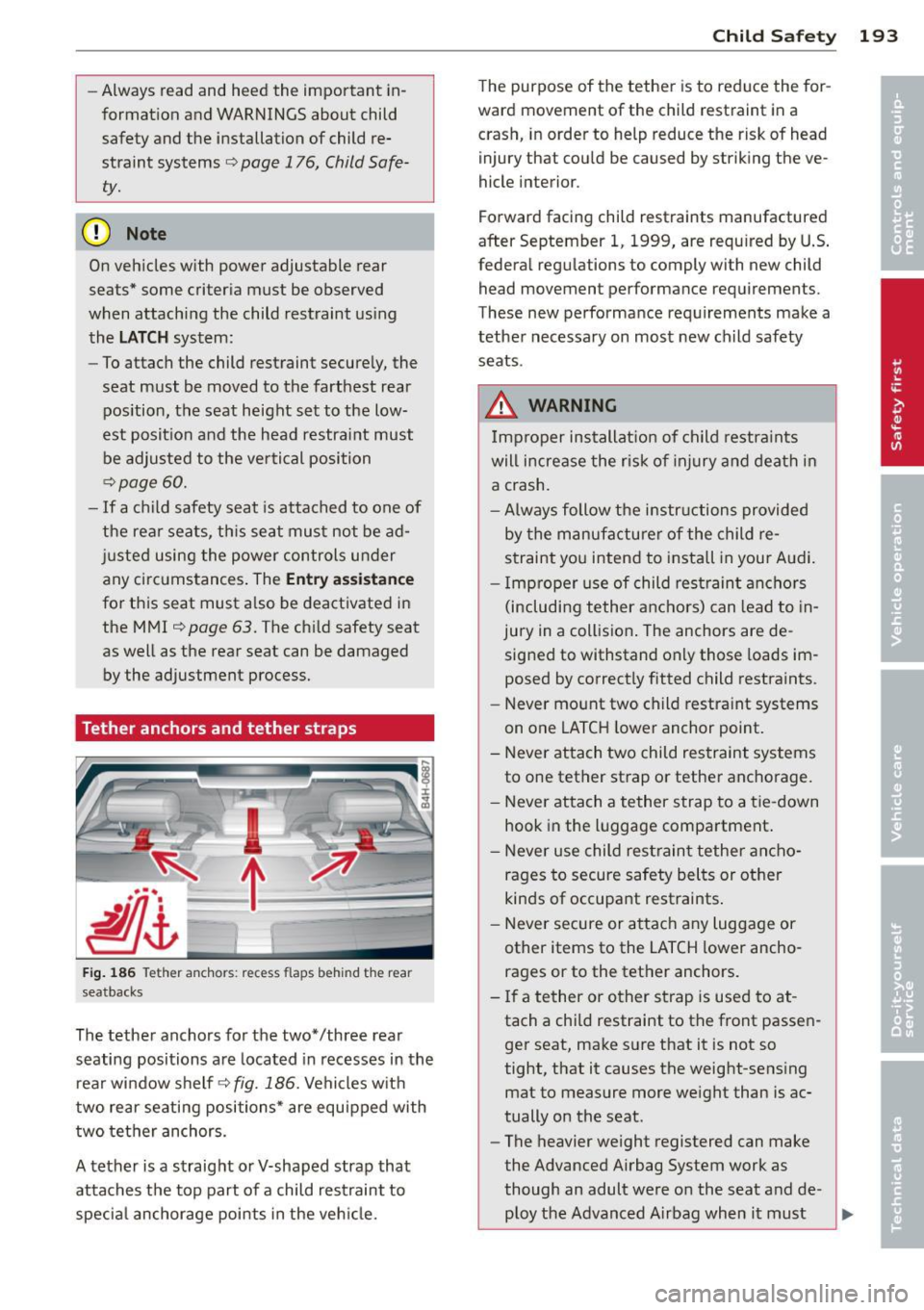
-Always read and heed the important in
formation and WARNINGS about child
safety and the installation of child re
straint systems
c:> page 176, Child Safe
ty.
(D Note
On vehicles with power adjustable rear
seats* some criteria must be observed
when attaching the child restraint using the
LATCH system:
- To attach the child restraint securely, the
seat must be moved to the farthest rear
position, the seat height set to the low
est position and the head restraint must be adjusted to the vertical position
¢ page 60.
-If a child safety seat is attached to one of
the rear seats, this seat must not be ad
justed using the power controls under
any circumstances. The
Entry assistance
for this seat must also be deactivated in
the MMI
¢ page 63. The child safety seat
as well as the rear seat can be damaged by the adjustment process.
Tether anchors and tether straps
Fig. 186 Tether an cho rs: reces s fl ap s b ehin d th e re ar
seatbacks
The tether anchors for the two* /three rear
seating positions are located in recesses in the
rear window shelf ¢
fig. 186. Vehicles with
two rear seating positions* are equipped with two tether anchors .
A tether is a straight orV-shaped strap that
attaches the top part of a child restraint to
special anchorage points in the vehicle.
Child Safety 193
The purpose of the tether is to reduce the for
ward movement of the child restraint in a
crash, in order to help reduce the risk of head
injury that could be caused by striking the ve
hicle interior .
Forward facing child restra ints manufactured
after September 1, 1999, are required by U.S.
federal regulations to comply with new child
head movement performance requirements.
These new performance requirements make a
tether necessary on most new child safety
seats .
.&_ WARNING
Improper installation of child restraints
will increase the risk of injury and death in
a crash.
- Always follow the instructions provided
by the manufacturer of the child re
straint you intend to install in your Audi.
- Improper use of child restraint anchors
(including tether anchors) can lead to in
jury in a collision . The anchors are de
signed to withstand only those loads im
posed by correctly fitted child restraints .
- Never mount two child restraint systems
on one LATCH lower anchor point.
- Never attach two child restraint systems to one tether strap or tether anchorage.
- Never attach a tether strap to a tie-down
hook in the luggage compartment.
- Never use child restraint tether ancho
rages to secure safety belts or other
kinds of occupant restraints.
- Never secure or attach any luggage or
other items to the LATCH lower ancho rages or to the tether anchors .
- If a tether or other strap is used to at
tach a child restraint to the front passen ger seat, make sure that it is not so
tight, that it causes the weight -sensing
mat to measure more weight than is ac
tually on the seat .
- The heavier weight registered can make
the Advanced Airbag System work as
though an adult were on the seat and de -
ploy the Advanced Airbag when it must ..,
Page 197 of 318
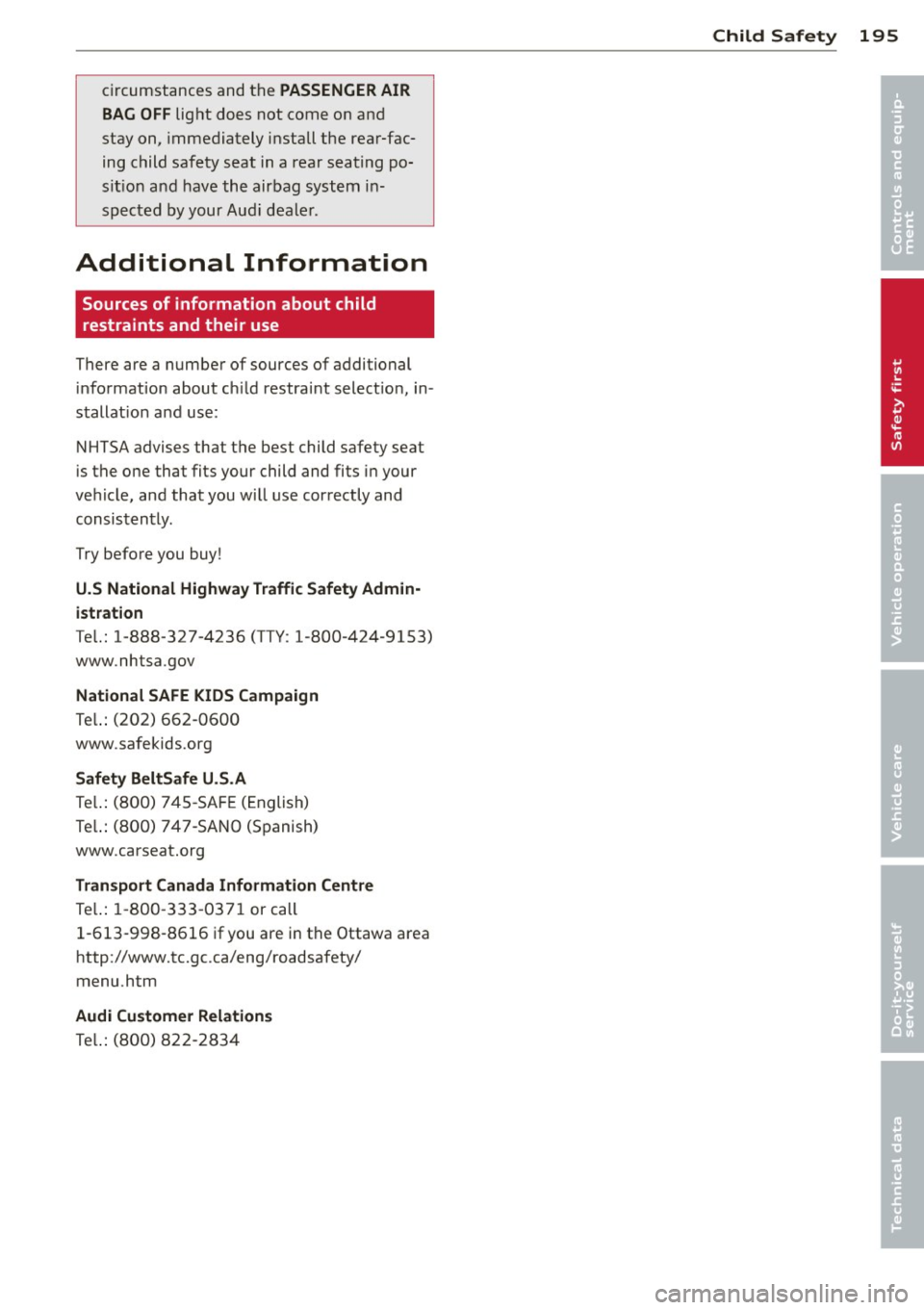
circumstances and the PASSENGER AIR
BAG OFF
li gh t does not come o n an d
stay on, immediately install the rear-fac
ing child safety seat in a rear seating po
sit ion and have the airbag system i n
spected by your Aud i deale r.
Additional Information
Sources of information about child
restraints and their use
There are a number of sources of additional
information about ch ild restraint select ion, in
stallat io n and use:
NHTSA advises that t he best child safety seat
is the one that fits your child and fits in your
ve hicle, and that you wi ll use correctly and
consisten tly.
Try before you buy!
U.S National Highway Traffic Safety Admin
i s tration
T e l. : 1 -888-327 -4236 (T TY : 1-800-424-9153)
www.nhtsa .gov
National SAFE KIDS Campaign
Te l.: (202) 662-0600
www.safekids.org
Safety BeltSafe U.S .A
Te l.: (800) 745 -SA FE (English)
Te l.: (800) 747 -SANO (Spanish)
www .carseat.org
Transpo rt Canada Info rm ation Cent re
Te l.: 1- 800 -333 -037 1 or call
1-613-998 -8616 if you are in the Ottawa area
http ://www.tc.gc.ca/eng/roadsafety/
menu .htm
Audi Customer Relations
Te l.: (800) 822 -2834
Child Sa fet y 195
•
•
Page 198 of 318
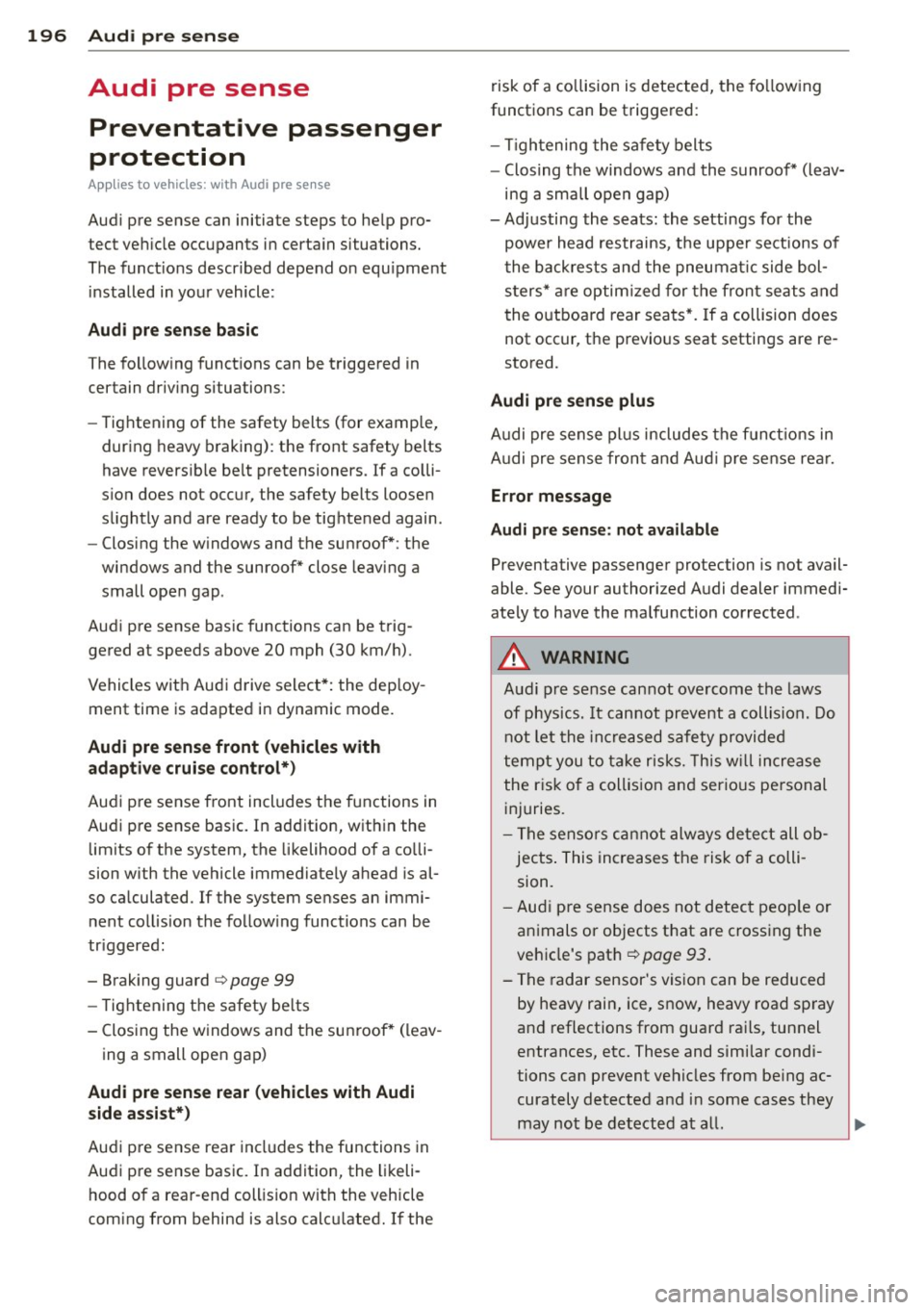
196 Audi pre sense
Audi pre sense
Preventative passenger
protection
A pp lies to veh icles: with Audi pre se nse
Audi pre sense can initiate steps to help pro
tect vehicle occupants in certain situations.
The functions described depend on equ ipment
installed in your vehicle:
Audi pre sense basic
The following functions can be triggered in
certain driving situations:
- Tightening of the safety belts (for example,
during heavy braking) : the front safety belts
have reversible belt pretensioners. If a colli
sion does not occur, the safety belts loosen
slightly and are ready to be tightened again.
- Closing the windows and the sunroof*: the
windows and the sunroof* close leaving a
small open gap.
Audi pre sense basic functions can be trig
gered at speeds above 20 mph (30 km/h).
Vehicles with Aud i drive select*: the dep loy
ment time is adapted in dynamic mode.
Audi pre sense front (vehicles with
adaptive cruise control*)
Audi pre sense front includes the functions in
Audi pre sense basic. In addition, within the
limits of the system, the likelihood of a colli
sion with the vehicle immediately ahead is al
so calculated . If the system senses an immi
nent collision the following functions can be
tr iggered :
- Braking guard
c::> page 99
- Tightening the safety be lts
- Closing the windows and the sunroof* (leav -
ing a small open gap)
Audi pre sense rear (vehicles with Audi
side assist*)
Audi pre sense rear includes the functions in
Audi pre sense basic. In addition, the likeli
hood of a rear-end collision with the vehicle
coming from behind is also calcu lated.
If the risk
of a co llision is detected, the following
functions can be triggered:
- Tig htening the safety belts
- Closing the windows and the sunroof* (leav-
ing a small open gap)
- Adjusting the seats: the settings for the
power head restrains, the upper sections of
the backrests and the pneumatic side bol
sters* are optim ized for the front seats and
the outboard rear seats*. If a collision does
not occur, the previous seat settings are re
stored.
Audi pre sense plus
Audi pre sense plus includes the funct ions in
Audi pre sense front and Audi pre sense rear.
Error message
Audi pre sense: not available
Preventative passenger protection is not avail
able. See your authorized Audi dealer immedi
ately to have the malfunction corrected .
A WARNING
-Audi pre sense cannot overcome the laws
of physics.
It cannot prevent a collision. Do
not let the increased safety provided
tempt you to take risks. This will increase
the risk o f a collision and serious personal
injuries.
- The sensors cannot always detect all ob
jects . This increases the risk of a colli
sion.
- Audi pre sense does not detect people or
animals or objects that are crossing the
vehicle's path
c::> page 93.
-The radar sensor's vision can be reduced
by heavy rain, ice, snow, heavy road spray
and reflections from guard rails, tunnel
entrances, etc. These and similar condi
tions can prevent vehicles from be ing ac
curately detected and in some cases they
may not be detected at all.
Ill>
Page 200 of 318
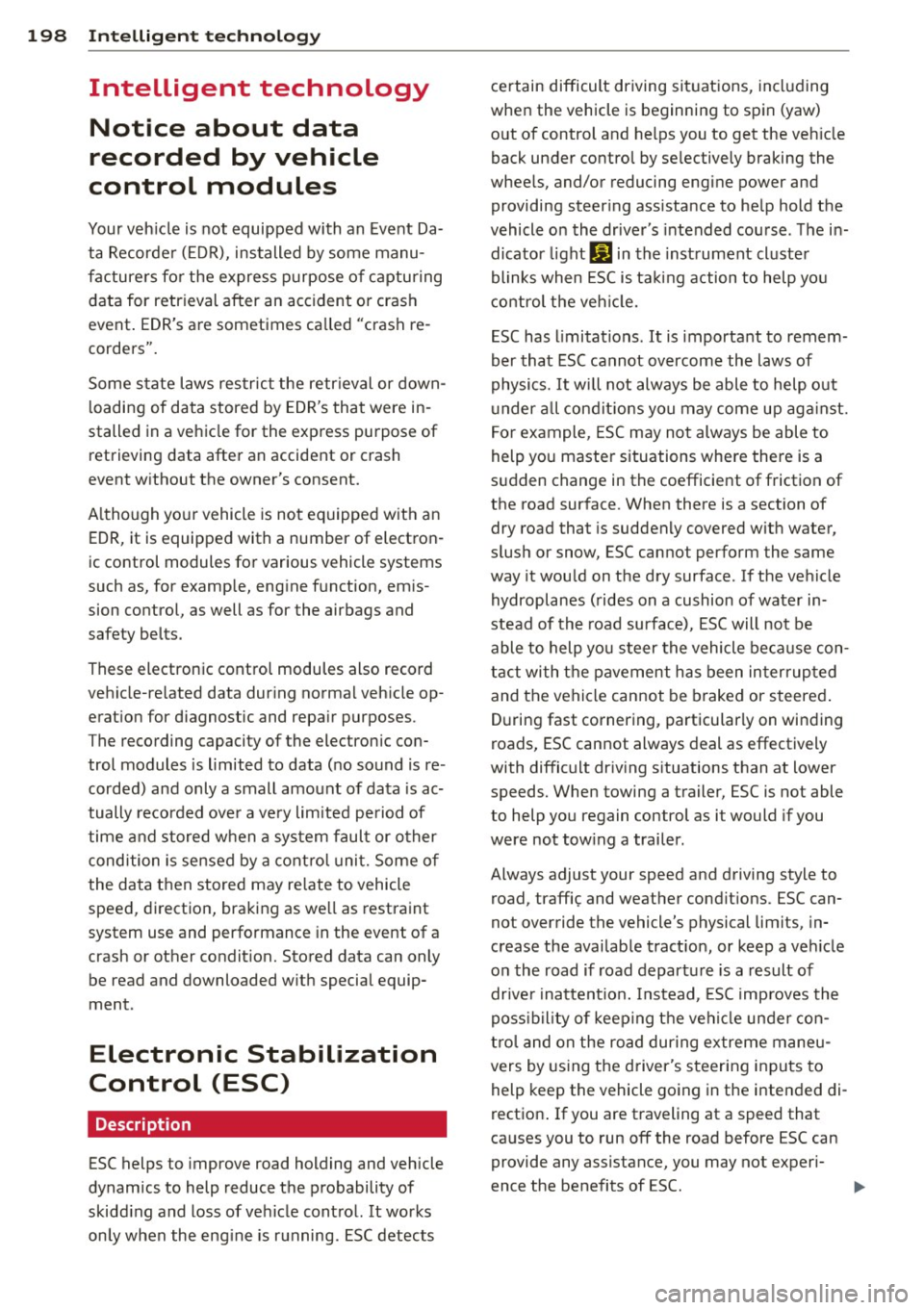
198 Intellige nt tec hno logy
Intelligent technology
Notice about data
recorded by veh ic le
control modules
Your vehicle is not equipped with an Event Da
ta Recorder (EDR), installed by some manu
facturers fo r the express purpose of capturing
data for retrieval after an accident or crash
event . EDR's are sometimes called "crash re
corders".
Some state laws restrict the retrieval or down
loading of data stored by EDR's that were in
stalled in a vehicle for the express purpose of
retrieving data after an accident or crash
event without the owner's consent.
A lthough your vehicle is not equipped with an
EDR, it is equipped with a number of electron
ic control modules for various vehicle systems
such as, for example, engine function, emis
sion control, as well as for the airbags and
safety belts.
These electronic control modules also record
vehicle-related data during normal vehicle op
eration for diagnostic and repair purposes.
The recording capacity of the electronic con
trol modules is limited to data (no sound is re
corded) and only a small amount of data is ac
tually recorded over a very limited period of
time and stored when a system fault or other
condition is sensed by a control unit. Some of
the data then stored may relate to vehicle
speed, direction, braking as well as restraint
system use and performance in the event of a
crash or other condition. Stored data can only
be read and downloaded with special equip
ment.
Electronic Stab ilization
Control (ESC)
Description
ESC helps to improve road holding and vehicle
dynamics to help reduce the probability of
skidding and loss of vehicle control. It works
only when the engine is running. ESC detects certain difficult driving situations, including
when the vehicle is beginning to spin (yaw)
out of control and helps you to get the vehicle back under control by selectively braking the
wheels, and/or reducing engine power and
providing steering assistance to help hold the
vehicle on the driver's intended course. The in
dicator light
G) in the instrument cluster
blinks when ESC is taking action to help you
control the vehicle.
ESC has limitations.
It is important to remem
ber that ESC cannot overcome the laws of
physics. It will not always be able to help out
under a ll cond itions you may come up against.
For example, ESC may not always be able to
help you master situations where there is a
sudden change in the coefficient of friction of
the road surface. When there is a section of
dry road that is suddenly covered with water,
slush or snow, ESC cannot perform the same
way it would on the dry surface . If the vehicle
hydroplanes (rides on a cushion of water in
stead of the road surface), ESC will not be
able to help you steer the vehicle because con
tact with the pavement has been interrupted
and the vehicle cannot be braked or steered.
During fast cornering, particularly on winding
roads, ESC cannot always deal as effectively
with difficult driving situations than at lower
speeds. When towing a trailer, ESC is not able
to help you regain control as it would if you
were not towing a trailer.
Always adjust your speed and driving style to road, traffic; and weather conditions. ESC can
not override the vehicle's physical limits, in
crease the available traction, or keep a vehicle
on the road if road departure is a result of
driver inattent ion. Instead, ESC improves the
possibility of keeping the vehicle under con
trol and on the road during extreme maneu
vers by using the driver's steering inputs to
help keep the vehicle going in the intended di
rection . If you are traveling at a speed that
causes you to run off the road before ESC can
provide any assistance, you may not experi
ence the benefits of ESC.
Page 227 of 318
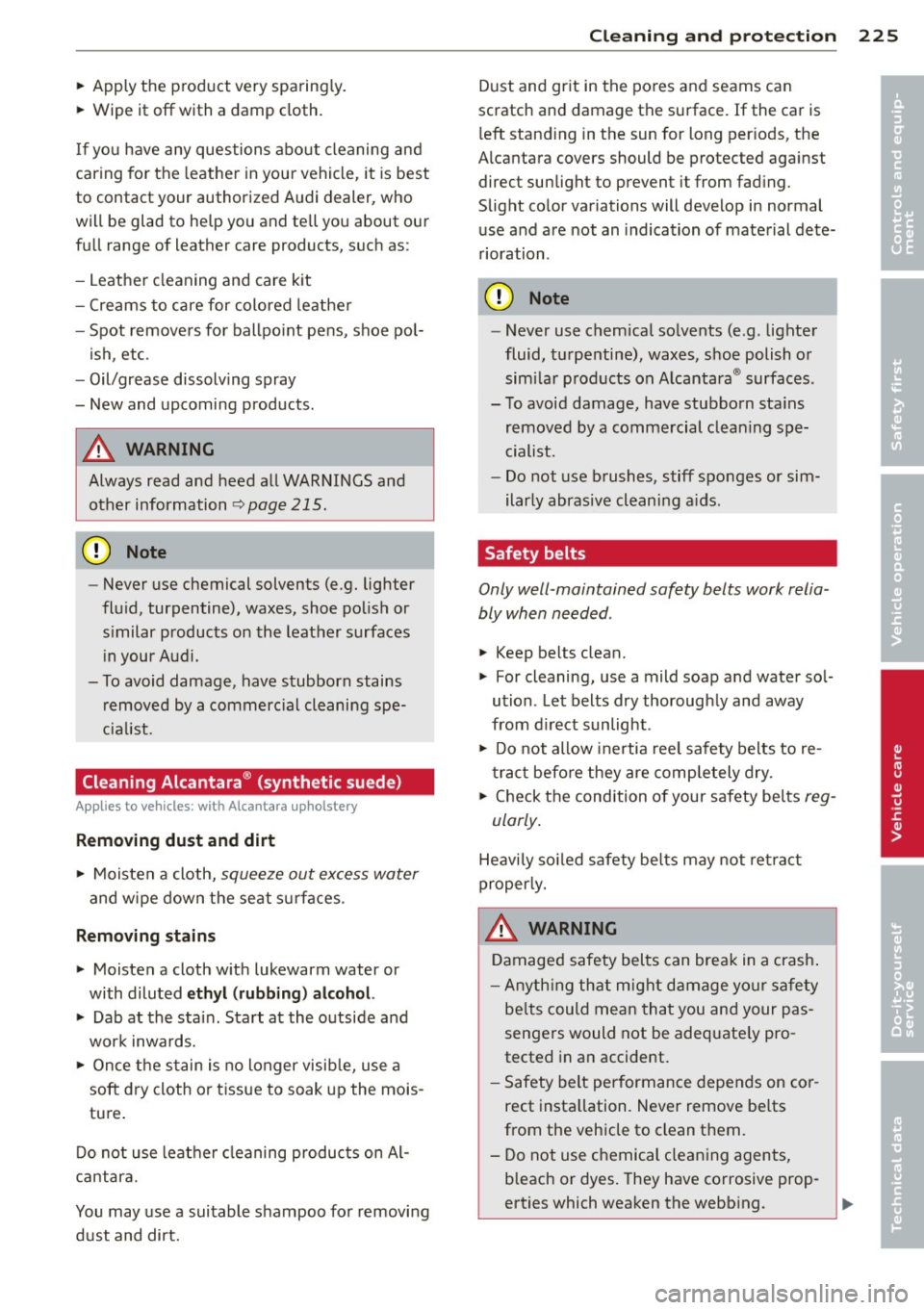
~ Apply the product very sparing ly .
~ Wipe it off with a damp cloth.
If you have any questions abo ut cleaning and
caring for the leather in your vehicle, it is best
to contact your authorized Audi dealer, who
will be glad to help you and tell you about our
fu ll range of leather care products, such as:
- Leather cleaning and care kit
- Creams to care for colored leathe r
- Spot removers for ballpo int pens, shoe pol-
ish , etc.
- Oil/grease dissolv ing spray
- New and upcoming products.
A WARNING
Always read and heed all WARNINGS and other information
~ page 215.
CD Note
- Never use chemical solvents (e.g. lighter
flu id, turpentine), waxes, shoe polis h or
s imilar products on the leather surfaces
i n your Audi.
- To avoid damage, have stubborn stains removed by a commerc ial cleani ng spe
cia list .
Cleaning Alcantara ® (synthetic suede)
Appl ies to vehicles : wit h Alcantara upholstery
Removing dust and dirt
~ Moisten a cloth, squeeze out excess water
and wipe down the se at su rfaces .
Removing stains
~ Moisten a cloth w ith lukewarm water or
with diluted ethyl (rubb ing) alcohol.
~ Dab at the stain. Start at the outside and
work inwa rds.
~ Once the s tain is no longer visib le, use a
soft d ry cloth or t issue to soak up the mois
tu re .
D o not use leather cleaning produc ts on Al
cantara.
You may use a suitable shampoo fo r removing
dust and dirt.
Cleaning and protec tion 225
D ust and gr it in the po res and seams can
scratch and damage th e surface. If the car is
l eft stand ing in the sun for long per iods, the
A lcantar a cover s should be protected aga inst
direct sunlight to prevent it from fad ing.
Slight co lor variations will develop in normal
use a nd are not an indication of mate rial dete
rioration .
CD Note
- Never use chemical so lvents (e.g . lighter
fluid, tu rpenti ne), waxes, shoe polish or
simi lar p roducts on A lcantara ® surfaces .
- T o avoid damage, have stubborn sta ins
removed by a comme rcial clean ing spe
cialist.
- Do not use b rushes, stiff sponges or sim
ilarly abrasive cleani ng a ids.
Safety belts
Only well -maintained safety belts work relia
bly when needed .
~ Keep belts clean.
~ For cleaning, use a mild soap a nd wate r so l
ution . Let belts dry thorough ly and away
from d irect sunlight .
~ Do not allow i nertia ree l safety belts to re
tract before they are comp letely dry.
~ Check t he condition of your safety belts reg
ularly .
Heavi ly so iled safety be lts may not ret ra ct
properly.
A WARNING ~
D amaged safety belts can break in a crash .
- Anyth ing th at m ight damage yo ur safety
be lts could mean tha t you and your pas
sengers would not be adequate ly pro
tected in an accident.
- Safety belt performance depends on cor
rect insta llation . Never remove be lts
from the vehicle to clean them.
- Do not use chemical cleaning agents,
b leach or dyes. They have corrosive prop
erties which weaken the webb ing .
•
•
Page 228 of 318
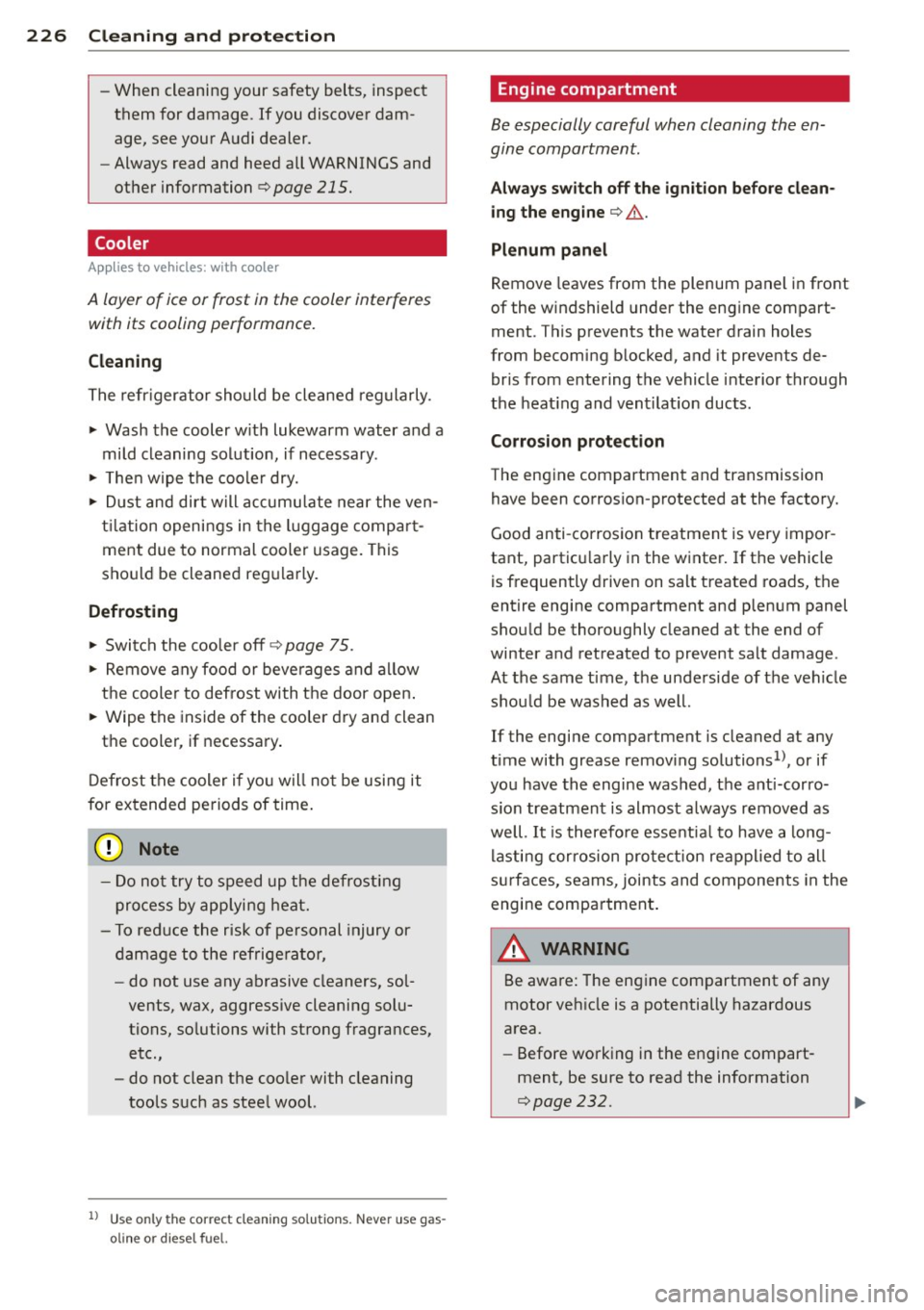
226 Cleaning and protec tio n
-When cleaning your safety belts, inspect
them for damage.
If you discover dam
age, see your Audi dealer .
- Always read and heed all WARNINGS and
other information
¢ page 215.
Cooler
Applies to vehicles: with cooler
A layer of ice or frost in the cooler interferes
with its cooling performance.
Cl ean ing
The refr igerator sho uld be cleaned regularly.
.. Wash the cooler w ith lukewarm water and a
mild cleaning solut ion, if necessary .
.. The n wipe the cooler dry.
.. Dust and dirt will accumu late near the ven
t il ation openings in the luggage compar t
ment due to normal cooler usage. This
should be cleaned regularly.
Defrost ing
.. Swi tch the cooler off¢ page 75.
.. Remove any food or beve rages and al low
the cooler to defrost with the door open .
.. Wipe the inside of the cooler dry and clean
the cooler , if necessary .
Defrost the cooler if yo u will not be using it
for extended periods of time .
@ Note
-Do not try to speed up the defrost ing
process by applying heat.
- To reduce the risk of personal injury or
damage to the refrigera to r,
- do not use any abrasive cleaners, sol
vents, wax, aggressive cleaning solu
tions, so lutions with strong fragrances,
etc.,
- do not clean the coo ler with cleaning
tools such as stee l wool.
1l Use o nly th e co rrect cle anin g so lu ti on s. Never use gas
o lin e or d ie se l fu el.
Engine compartment
Be especially careful when cleaning the en
gine compartment.
Always switch off the ign it ion before cle an
i ng th e eng in e¢ .&. .
Plenum panel
Remove leaves from the plenum panel i n front
of the windshield under the engine compart
ment. This prevents the water drain holes
from becoming b locked, and it prevents de
bris from entering the vehicle interior through
the heat ing and ventilat ion ducts .
Corrosi on protect ion
The engine compartment and transmission
have been corrosion-protected at the factory .
Good anti-corrosion treatment is very impor
tant, partic ularly in the winter.
If the vehicle
is frequently driven on salt treated roads, the
entire engine compartment and plenum panel
shou ld be thoroughly cleaned at the end of
winter and retreated to prevent salt damage .
At the same time, the underside of t he veh icle
shou ld be washed as well.
If the engine compartment is cleaned at any
time with grease remov ing solutions
1>, or if
you have the engine washed, the anti-corro
s ion treatment is almost a lways removed as
well . It is therefo re esse ntia l to have a lo ng
lasti ng corrosion pro te ct ion reapplied to all
surfaces, seams, joints and components in the
engine compartment .
A WARNING
Be aware: The engine compartment of any
motor vehicle is a potentially hazardous
area.
- Before working in the engine compart
ment, be sure to read the information
¢page 232.
Page 235 of 318

-Always disconnect the battery.
- Never smoke or work near heaters or open flames. Fluids in the engine com
partment could start a fire.
- Keep an approved fire extinguisher im
mediately available.
- To avoid electrical shock and personal in
jury while the engine is running or being
started, never touch :
- Ignition cables
- Other components of the high voltage
electronic ignition system.
- If you must perform a check or repair
with the engine running:
- First, fully apply the parking brake,
move selector lever to "P" (Park).
- Always use extreme caution to prevent
clothing, jewelry, or long hair from get
ting caught in the radiator fan, V-belts
or other moving parts, or from contact ing hot parts. Tie back hair before
starting, and do not wear clothing that
will hang or droop into the engine.
- Minimize exposure to emission and
chemical ha zards c:::> & .
A WARNING
California Proposition 65 Warning:
- Engine exhaust, some of its constituents,
and certain vehicle components contain
or emit chemicals known to the State of
California to cause cancer and birth de
fects and reproductive harm. In addition ,
certain fluids contained in vehicles and
certain products of component wear con
tain or emit chemicals known to the
State of California to cause cancer and
birth defects or other reproductive harm .
Checking and filling 233
-Battery posts, terminals and related ac
cessories contain lead and lead com
pounds, chemicals known to the State of
California to cause cancer and reproduc
tive harms. Wash hands after handling.
(D Note
When adding fluids, always make sure that
they are poured into the proper container
or filler opening, otherwise serious dam
age to vehicle systems will occur.
(® For the sake of the environment
To detect leaks in time, inspect the vehicle
floor pan from underneath regularly . If
you see spots from oil or other vehicle flu ids, have your vehicle inspected by an au
thorized Audi dealer.
Closing the engine hood
.,. Pull the hood down until the pressure from
the struts is reduced.
"' Let the hood
drop down and latch in place.
Do not try to push it shut; it may fail to en
gage
c:::> ,A .
A WARNING
-
A hood that is not completely latched
could fly up and block your view while driv
ing .
- When you close the engine hood, check it
to make sure the safety catch has proper ly engaged. The hood should be flush
with the surrounding vehicle body parts.
- If you notice while driving that the hood
is not secured properly , stop at once and
close it. •
•